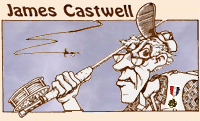|
Your word for today is 'drift.' One of its meanings
relates to a very common fault in fly-casting, the
tendency to move your fly-rod after you have made
the stop on the back-cast. I wrote about this back in
February of 2000,
and it's important enough to bring up again. There
is nothing new on the subject but perhaps I can use
some other words to help impress you how valuable
the proper control of it can be.
One of the many fun times at our 'Fish-In's' is casting
all the new rods we bring with us. Sometimes we do a
little casting-coaching at the same time when requested
and we usually put on a clinic of sorts at least once
during the event. During the last such outing it was
brought home to me again just how pervasive 'negative-drift'
can be.
One of the guys, a pal of ours for several years, but
who we only get to see once a year at these events was
playing with one of the new rods. He has been fly-fishing
for years and is very accomplished. Nothing shabby
about his casting either. As I happened to glance over
at him, laying out about 40 feet of line, I noticed
a slight 'negative-drift.' That is, after he had made
his back-cast, as the line was rolling out to the rear,
he would bring his rod forward to vertical.
No big deal, the cast was working just fine. I remembered
though that he had tried to correct that problem back in
Montana about seven years ago, but here it was again. Was
it a fault, was he doing something wrong? Yes. It was both
of those and more. It took away some of the power of his
cast and helped to promote a tailing-loop.
By not keeping the rod at the exact place where it stopped
on the back-cast and moving it forward in line with his body
he had little of the rod left to make the forward cast with.
His resultant stroke had to be a short punch from vertical
to the forward stop, not the longer smooth power stroke of
60 or 70 degrees with that amount of line out. The longer
stroke allows the rod to bend deeper and load more and
results in a better and easier cast.
I mentioned it to him, he made the correction and
immediately his cast improved. He had simply forgotten
over the years. It can happen and often does. The next
chance you have to watch someone's casting see if you
can spot the 'negative-drift.' Chances are you will
not have trouble finding it, it is very common. Have
them watch you. Then see if both of you can stick the
rod where it stops on the back-cast, wait until the
line has opened behind you and then and only then start
your forward stroke. You may be surprised and rewarded
with a smoother, more powerful, and less tiring forward
cast.
~ James Castwell
|



